An interview with Scot Quandra of the Dogwood Alliance:
Cellulosic biofuels endanger old-growth forests in the southern U.S.
Jeremy Hance, mongabay.com
October 16, 2008
Cellulosic biofuel is on its way. This second generation biofuel — so-called because it does not involve food crops — has excited many researchers and policymakers who hope for a sustainable energy source that lowers carbon emissions. However, some believe that cellulosic biofuel may prove less-than-perfect. Just as agricultural biofuels have gone from being considered 'green' to an environmental disaster, some think the new rush to cellulosic biofuel will follow the same course.
Scot Quaranda is one of those concerned about cellulosic biofuel’s impact on the environment. Campaign director at the Dogwood Alliance, which he describes as "the only organization in the Southern US holding corporations accountable for the impact of their industrial forestry practices on our forests and our communities", Quaranda condemns cellulosic biofuels as dangerous to forests “by its very definition”.
The southern forests of the United States contain a wealth of biodiversity, ecosystem types, and watersheds. However, the region is also the world’s largest paper producer for everything from office supplies to packaging to fast food containers. Currently 43 million acres of what was once old-growth forest are now paper-producing plantations.
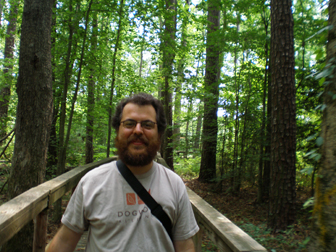 Scot Quandra from Dogwood Alliance at Great Dismal Swamp National Wildlife Refuge: 110,000 acres of forested wetland |
“Large amounts of carbon have been released in the industrialization of the southern forests, biodiversity has greatly suffered leaving many species endangered, ecosystem types have dwindled to smaller and smaller pockets, and watersheds have been ruined,” Quaranda says. “Despite the pressure of the paper industry, there are forests left which remain pristine. Now, however, a new threat looms.”
The new threat is cellulosic biofuels. “Tree-based biofuels, also known as cellulosic ethanol, is a product that will be produced from wood waste, pulpwood and wood chips by converting the cellulose to a liquid fuel through either a thermal or enzymatic process,” Quaranda says, adding that “cellulosic ethanol can also be created from other cellulose-rich plants like switch grass and jatropha.”
According to Quaranda sixteen bioenergy projects are currently underway in the South, one of which will be online in as early as 2009.
“The future of these magnificent forests and the people of the region whom have come to rely on them are seriously in jeopardy should cellulosic ethanol go into large-scale production,” Quaranda warns. “More forests will be cut down, a greater number of greenhouse gases will be released into the atmosphere, air and water quality will be compromised, and our already taxed water supply will be further depleted, threatening both our environment and quality of life.”
 White Marsh Clearcut, outside of the Green Swamp Preserve, North Carolina. Credit: Abigail Singer |
In addition to additional clear-cutting, cellulosic biofuel will strip forests of their ability to regenerate, says Quaranda. “The industry states it will initially rely on ‘wood waste’ for production. As it stands now, over 90% of all wood waste from sawmills and paper production is already accounted for and the additional waste would mean stripping every last twig from the forest when they are clear-cut leaving nothing behind to replenish the soils, slow sedimentation or provide wildlife habitat.”
Cellulosic biofuel is being touted—like first generation biofuels once were—as a possible solution to sustainable domestic energy crisis. Quaranda says that will not be the case if cellulosic biofuel uses forests as fuel: “natural forests and forests managed on long rotations store and sequester more carbon than plantations – over the past several decades, millions of acres of natural forests in the South have been converted to plantations managed on short rotations”. Quaranda worries many more millions of acres will be converted for this new fuel, creating a carbon source rather than a carbon sink.
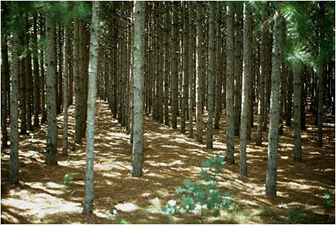 Pine plantation. Credit: Eva Hernandez |
“Current projections lead us to believe that cellulosic ethanol production will be done at such a scale that sustainability becomes impossible,” Quaranda told mongabay.com. “The fact of the matter is that in addition to competing with an already unsustainable paper industry, cellulosic ethanol will lead to increased clear-cutting, logging of endangered forests, conversion to plantations, and high impact business as usual forestry.”
Quaranda emphasizes that it is not too late for the preservation of southern forests. “The best thing that we can do is become better stewards of the land and make smarter land management decisions. This means more conservation of forests, truly sustainable forest management practices, and rejecting false solutions to our energy crisis like cellulosic ethanol.”
In an interview with mongabay.com in October 2008, Quaranda discussed the threat of cellulosic biofuel to the United States’ southern forests and what should be done to mitigate the danger.
DOGWOOD ALLIANCE and SOUTHERN FORESTS
Mongabay: What is the goal of Dogwood Alliance?
Scot Quaranda: Dogwood Alliance is the only organization in the Southern US holding corporations accountable for the impact of their industrial forestry practices on our forests and our communities. By continuously applying grassroots pressure, we insist companies take the lead in creating real and lasting protection for endangered Southern forests.
Mongabay: What makes the United States' southern forests unique?
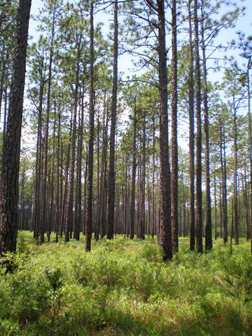 Natural forest in Green Swamp Preserve, North Carolina. Credit: Eva Hernandez |
Scot Quaranda: Southern forests are the most biologically diverse in North America and in many cases, the world. Unfortunately, the unique challenge that we face in the South is that 90% of the forests are privately owned and lack any legal protections.
Southern forests contain some of the most biologically rich ecosystems in North America. From the Gulf Coast, Ozark Mountains and Southern Appalachians to the pine woods and swamps of the East Coast, Southern forests house an abundance of plant and animal diversity and pristine watersheds. Many of the region's plant and aquatic species can be found nowhere else in the world.
Southern forests contain:
Mongabay: What is the importance of southern forests to current climate change?
Scot Quaranda: Southern forests play a key role in slowing global warming — From 1990 – 2004, Southern Forests offset the emissions from nearly 2 million cars. However, most major paper companies in the region continue business as usual practices that are driving the destruction of these important forests. Without positive action, a critical opportunity is being lost.
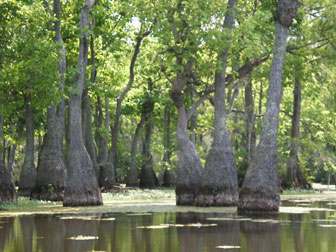 Cypress Swamp–Merchant’s Mill Pond. Image courtesy of the Dogwood Alliance. |
Natural forests and forests managed on long rotations store and sequester more carbon than plantations – over the past several decades, millions of acres of natural forests in the South have been converted to plantations managed on short rotations. We currently have 43 million acres of pine plantation in the South.
The South has greatest forest productivity and ability to increase carbon stores in the United States, but research suggests unless we alter our current course the South will become a net carbon emitter. Our forests contain some of the most threatened carbon stores in the world. Unfortunately, in the absence of incentives, private landowners in the South are unlikely to take action.
Mongabay: What are some of Dogwood Alliance’s past successes?
Scot Quaranda: Southern activists formed Dogwood Alliance in November 1996. Originally, Dogwood Alliance focused on stopping the expansion of chip mills – facilities that grind whole logs into wood chips for making paper and chipboard — across the South. Since our founding we have had successes at the state, national and corporate level in increasing real and lasting protection for our forests.

|
Since 2000, we have secured environmental paper policies and on the ground action from all of the top office supply companies including Staples, Office Depot, OfficeMax, FedEx/Kinko’s and Corporate Express. We have also reached landmark agreements with major paper companies including AbitibiBowater, North America’s largest newsprint manufacturer, and are currently campaigning on reform of paper packaging in the music, health & beauty and fast food sectors.
THREAT OF TREE-BASED BIOFUELS TO FORESTS
Mongabay: Can you tell us what cellulosic ethanol is?
Scot Quaranda: Tree-based biofuels, also known as cellulosic ethanol, is a product that will be produced from wood waste, pulpwood and wood chips by converting the cellulose to a liquid fuel through either a thermal or enzymatic process. Cellulosic ethanol can also be created from other cellulose-rich plants like switch grass and jatropha. Cellulosic ethanol is categorized as a second generation biofuel, reflected that it is made from a non-food crop.
Mongabay: What specific threat does cellulosic ethanol pose to America's southern forests?
Scot Quaranda: The Southern US is currently the largest paper producing region in the world. Add to this the fact that it is the region seeing the largest amount of interest for cellulosic ethanol production in North America and the future of these magnificent forests and the people of the region whom have come to rely on them are seriously in jeopardy should cellulosic ethanol go into large-scale production. More forests will be cut down, a greater number of greenhouse gases will be released into the atmosphere, air and water quality will be compromised, and our already taxed water supply will be further depleted, threatening both our environment and quality of life.
Mongabay: What is lost when natural forest is converted to tree plantations?
Scot Quaranda: According to Harvard biologist E.O. Wilson, a pine plantation is 90-95% less diverse than a natural forest. Essentially this means the only thing that grows in a pine plantation is pine trees. You destroy the diversity and habitat found in a natural forest. Additionally, the management of pine plantations degrades soil and water quality, lessens carbon intake as natural forests have been proven to be better at sequestering carbon, and increase the reliance on toxic fertilizers and herbicides for forest management which has an impact both on water quality and human health.
Mongabay: How would cellulosic ethanol affect the large number of wetlands and water quality in general in the South?
Scot Quaranda: The South has the highest concentration of wetlands in the US, 75% of which are forested. The greatest percentage of forested wetlands loss over the last 50 years has come from the clear-cutting, ditching and draining of these forests for conversion to pine plantations. A thriving cellulosic ethanol industry will require more forests to meet demand which will mean increased ditching and draining and conversion of these forests to plantations. This leads to more wetland destruction which destroys critical habitat, reduces protection from flooding and storm surge associated with global warming, and harms overall water quality. Forested wetlands provide clean drinking water for a large percentage of Americans including the entirety of New York City. We need to protect and preserve our wetlands not destroy them to produce biofuel.
Mongabay: Current biofuels have been shown to cause considerable environmental damage both directly and indirectly to forests around the world, do you think there is any way cellulosic ethanol could be sustainable or is it a danger to forests by its very definition?
Scot Quaranda: Current projections lead us to believe that cellulosic ethanol production will be done at such a scale that sustainability becomes impossible. Therefore it is a danger to forests by its very definition. The fact of the matter is that in addition to competing with an already unsustainable paper industry, cellulosic ethanol will lead to increased clear-cutting, logging of endangered forests, conversion to plantations, and high impact business as usual forestry.
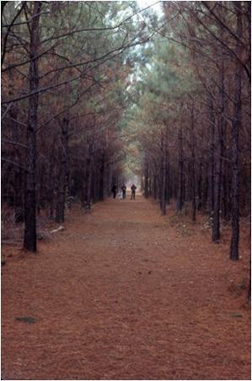 Pine plantation. Credit: Eva Hernandez |
A good example to illustrate the potential threat is that the industry states it will initially rely on “wood waste” for production. As it stands now, over 90% of all wood waste from sawmills and paper production is already accounted for and the additional waste would mean stripping every last twig from the forest when they are clear-cut leaving nothing behind to replenish the soils, slow sedimentation or provide wildlife habitat. Based on production projections, the industry will move quickly from wood waste to pulpwood and wood chips which again mean more clear-cutting, logging of endangered forests and conversion of natural forests to plantations.
Mongabay: Have projects already begun for tree-based fuel in the south? How long before companies may begin harvesting trees for fuel?
Scot Quaranda: Sixteen new bio-energy projects have been announced for the Southern US over the past two years, which will lead to intense competition for wood waste and eventually chips. Three of those facilities are slated to be biofuel facilities – Gulf Coast Energy in Mossy Head, FL, Range Fuels in Soperton, GA, and BlueRidgeXethanol in Spring Hope, NC.
Range Fuels is currently in the construction phase and expects to be online by the end of 2009 and in full production by early 2010. Though the Range Fuels facility is likely the first to be open and these numbers may seem small at first, the market is waiting for the first to succeed in order to begin rapidly investing in future mills which will have massive compounding results and devastating impacts for our forests and communities.
Additionally, as noted above, there are also thirteen facilities under consideration or in operation that will burn wood waste, wood chips and residuals for energy. For example, the Green Circle Energy facility in Florida is already creating wood pellets from the forests of North Florida and exporting them to Europe in order for countries of the EU to be able to meet their renewable energy standards.
OTHER THREATS TO SOUTHERN FORESTS
Mongabay: Southern forests are under incredible pressures. What are some of the most significant other than cellulosic ethanol?
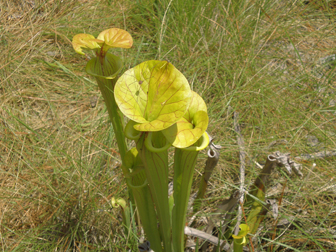 Pitcher plant in Green Swamp Preserve, North Carolina. Credit: Eva Hernandez |
Scot Quaranda: According to the US Forest Service, the South produces more timber than any other single country in the world, and it is projected to be the dominant producing region for many decades to come. The dominant share of the region's timber is going to pulp and paper production. The South is currently the largest paper-producing region in the world, producing approximately 60% of the US paper supply and 15% of the world's paper supply. This industry is driving the destruction of our forests through industrial-scale clearcutting and the conversion of forests and wetlands to intensively managed tree plantations.
Other threats to our forests include: conversion to non-forest uses like suburban sprawl and development, a massive influx of forest pests and invasive species, and the conversion of forests to agricultural lands for the production of first generation biofuels like corn and soy beans for ethanol and new second generation crops like switch grass.
Mongabay: Does climate change appear to be a threat to southern forests?
Scot Quaranda: Climate change has the potential to have significant impacts on Southern forests. The forests of our region should be conserved or manage sustainably in order to provide critical carbon storage to battle global warming. Instead they are being exploited for paper production and energy generation. This will lead to our forests becoming a net carbon emitter.
We have already seen the impact of climate change on our forests in two ways. In places like the Appalachian Mountains, where there are numerous ecosystems that exist nowhere else in the country, rising temperatures and longer warm seasons are killing off critical tree species. Additionally, we are feeling the impact of climate change through a massive increase in invasive species and pests, notably the hemlock wood adelgid for example which is expected to wipe out our entire hemlock population within 20 years.
Additionally, rising sea levels associated with climate change is expected to have a major impact on our coastal forests through salt water moving further inland which will kill off trees as has been seen in some cypress populations in Southeastern NC and it is expected that additional populations on the coast will see a significant impact.
Mongabay: How is biodiversity faring in these forests? Are there any specific animals that are especially in need of protection?
Scot Quaranda: There are 14 forest community types in the South that have been reduced to less than 2% of their original range. Additionally, there are 25 forest community types that are at less than 15% of their original range and another 11 at less than 30% of their original range.
In terms of plant and animal species, the Southern US has more endangered plant and animal species than any other region in the country. On the Atlantic coast, carnivorous plants such as the Venus Flytrap and Pitcher Plant are threatened by extinction. Birds such as the Cerulean Warbler and Red-Cockaded woodpecker are threatened and countless salamanders, turtles, toads and freshwater mussels hang on the brink of extinction.
Mongabay: What can Southerners do to protect their forests? How about those who don't live in the region, how can we help?
Scot Quaranda: When it comes specifically to Southerners, the best thing that we can do is become better stewards of the land and make smarter land management decisions. This means more conservation of forests, truly sustainable forest management practices, and rejecting false solutions to our energy crisis like cellulosic ethanol.
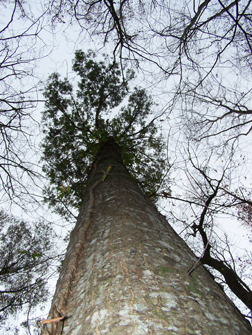 Pitcher plant in Green Swamp Preserve, North Carolina. Credit: Eva Hernandez |
That said, the entire Western world is accountable to not only Southern forests but forests around the globe and everyday decisions have an impact on whether we move towards a truly green world or continue with business as usual practices that have gotten us into our current predicament. We need to examine our levels of consumption as it relates to forests and energy. We need to use less, consume smartly, and make sure that you are getting the most out of what you choose to consume, and we need to hold corporations accountable for their decisions that have a tremendous impact on our forests.
Anyone can write a letter to the editor, sign a petition, make a phone call to the CEO of a company or your legislator to make sure they are aware of the threat of cellulosic ethanol to our forests and our communities in the Southern US and around the world.
Instead of government subsidies going to cellulosic ethanol production in a highly unregulated industry with a lot of unknown variables, the smartest investment we could make in this country right now is in conservation and efficiency. We need to protect our forests as vital carbon reserves, increase the gas mileage in our cars and trucks, invest in hybrid and electric vehicle technology, keep up on the maintenance on our current automobiles, increase investment in alternative and public transportation, build smarter walkable and bikeable communities, invest in less intense natural solutions like fuel from algae, and look at our own individual habits while working to minimize our carbon footprints.
In addition to the cellulosic ethanol production in the Southern US, Western society is looking to the global South to provide their “sustainable” energy needs. From palm oil production in Indonesia and Southeast Asia to Jatropha production in Africa and Sugar and cellulosic ethanol production in Central and South America, our global forests and communities are at risk if we embrace these false solutions. Now is the time to reinvest in research and development of positive solutions, not get bogged down in short-term, short-sighted solutions. Our forests and communities in the Southern US and worldwide depend on that.
Dogwood Alliance
Fast-food industry destroying forests in the Southern U.S. April 28, 2008
The Southern forests of North America supply 60% of US and 15% of global paper demands. Deforestation for wood and paper products, along with urban sprawl, has resulted in a total decline from 356 million acres in colonial times to 182 million acres today. The South contains more threatened forest ecosystems than anywhere else in the US. A major perpetuator of deforestation in the South is the fast food industry. With nearly 100 paper packaging mills in the South and thousands of restaurants worldwide, major fast food retailers such as KFC and Taco Bell are leaders in paper consumption and subsequent waste. The Dogwood Alliance (dogwoodalliance.org), a nonprofit organization formed to increase awarness of the importance of Southern forests and the threats their survival, has launched a new campaign at nofreerefills.org which specifically targets the paper packaging practices of the fast food industry.
Paper packaging devours south-eastern forests in the US February 10, 2008
The Dogwood Alliance has released a report highlighting the damage done by paper pulp mills and their corporate customers to America’s Mid-Atlantic Coastal Forests. The forests, which span from Delaware through the Carolinas to Georgia, are extremely rich in biodiversity; scientists have catalogued over two-thousand terrestrial species, including thirty-two endemic species. Probably the most famous endemic species is the Venus flytrap; this strange carnivorous plant is native to an area only 10 by 100 square miles in North Carolina. A study by WWF determined that both species richness and endemism is even higher for freshwater aquatic species.
U.S. forests suffer from beauty products packaging February 14, 2007
Every year millions of acres of forests in the southern United States are cut to fuel the pulp and paper industry. Nearly 25 percent of this demand comes from paper packaging, which usually ends up in landfills after a brief life as a disposable product. To support this industry, millions of acres of natural forest have been converted into fast-growing pine plantations — in fact, the U.S. Forest Service estimates that nearly twenty percent of Southern forests are now pine plantations. Nationwide the United States lost an average of 831 square miles (531,771 acres) of old-growth forest per year according to official figures, the seventh highest loss in the world.